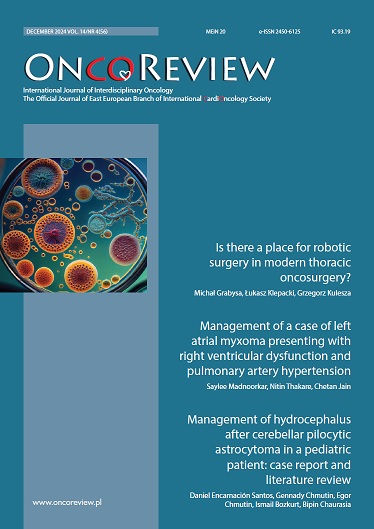Management of hydrocephalus after cerebellar pilocytic astrocytoma in a pediatric patient: case report and literature review Case report
Main Article Content
Abstract
Background: Pilocytic astrocytoma (PA) is the most common brain malignancy in children. PA is a distinct histological and biological subgroup of gliomas that have a slow growth rate. Most PAs are located infratentorial and in the median cerebral structures such as the optic nerve, brain stem, and hypothalamus. Hydrocephalus is a common finding in patients with PA.
Case presentation: In this report, we describe a case of a patient treated surgically for PA who developed a common complication – hydrocephalus. Pre-operative dilatation of the lateral ventricles with transependymal cerebrospinal fluid flow along with her young age were defined as the risk factors. She required numerous interventions and the findings along with treatment modalities are discussed in detail.
Conclusions: Cases with pre-existing risk factors for post-operative hydrocephalus should be evaluated prophylactic cerebrospinal fluid diversion surgery. If a more conservative approach is employed, the patients’ neurological status and ventricle size should be closely monitored. Pediatric patients are negatively affected with repetitive surgeries in terms of physical and mental health. Thus, in order to avoid additional interventions, pre-operative planning of all available options should be discussed with the family.
Downloads
Metrics
Article Details

This work is licensed under a Creative Commons Attribution-NonCommercial 4.0 International License.
Copyright: © Medical Education sp. z o.o. This is an Open Access article distributed under the terms of the Attribution-NonCommercial 4.0 International (CC BY-NC 4.0). License (https://creativecommons.org/licenses/by-nc/4.0/), allowing third parties to copy and redistribute the material in any medium or format and to remix, transform, and build upon the material, provided the original work is properly cited and states its license.
Address reprint requests to: Medical Education, Marcin Kuźma (marcin.kuzma@mededu.pl)
References
2. Su J, Guo S, Chen Z et al. Efficacy of various extent of resection on survival rates of patients with pilocytic astrocytoma: based on a large population. Sci Rep. 2024; 14(1): 24646. https://doi.org/10.1038/s41598-024-75751-0.
3. Hafez A, Fahmy M, Hassan T et al. Gamma Knife Radiosurgery for symptomatic eloquently deep-seated cystic pilocytic astrocytoma mural nodules: Retrospective case series of effective outcomes. Acta Neurochir (Wien). 2024; 166(1): 466. https://doi.org/10.1007/s00701-024-06366-7.
4. Collins P, Jones T, Giannini C. Pilocytic astrocytoma: pathology, molecular mechanisms, and markers. Acta Neuropathol. 2015; 129(6): 775-88. https://doi.org/10.1007/s00401-015-1410-7.
5. Kristiansen I, Frykberg E, Höglund A et al. Motor performance after treatment of pilocytic astrocytoma in the posterior fossa in childhood. Cancer Rep (Hoboken). 2022; 5(8): e1548. https://doi.org/10.1002/cnr2.1548.
6. Bornhorst M, Frappaz D, Packer J. Pilocytic astrocytomas. Handb Clin Neurol. 2016; 134: 329-44. https://doi.org/10.1016/B978-0-12-802997-8.00020-7.
7. Won Y, Dubinski D, Behmanesh B et al. Management of hydrocephalus after resection of posterior fossa lesions in pediatric and adult patients-predictors for development of hydrocephalus. Neurosurg Rev. 2020; 43(4): 1143-50. https://doi.org/10.1007/s10143-019-01139-8.
8. Lin T, Riva-Cambrin K. Management of posterior fossa tumors and hydrocephalus in children: a review. Childs Nerv Syst. 2015; 31(10): 1781-9. https://doi.org/10.1007/s00381-015-2781-8.
9. Anetsberger S, Mellal A, Garvayo M et al. Predictive Factors for the Occurrence of Perioperative Complications in Pediatric Posterior Fossa Tumors. World Neurosurg. 2023; 172: e508-e516. https://doi.org/10.1016/j.wneu.2023.01.063.
10. Kumar A, Bhaisora S, Rangari K et al. An Analysis of Temporal Trend of Incidence of Post-Resection Cerebrospinal Fluid Diversion in Pediatric Posterior Fossa Tumor Patients and the Predictive Factors. Neurol India. 2023; 71(1): 79-85. https://doi.org/10.4103/0028-3886.370456.
11. Muthukumar N. Hydrocephalus Associated with Posterior Fossa Tumors: How to Manage Effectively? Neurol India. 2021; 69(Supplement): S342-9. https://doi.org/10.4103/0028-3886.332260.
12. Schneider C, Ramaswamy V, Kulkarni V et al. Clinical implications of medulloblastoma subgroups: incidence of CSF diversion surgery. J Neurosurg Pediatr. 2015; 15(3): 236-42. https://doi.org/10.3171/2014.9.PEDS14280.
13. Beuriat A, Puget S, Cinalli G et al. Hydrocephalus treatment in children: long-term outcome in 975 consecutive patients. J Neurosurg Pediatr. 2017; 20(1): 10-8. https://doi.org/10.3171/2017.2.PEDS16491.
14. Encarnacion D, Chmutin G, Chaurasia B et al. Hundred Pediatric Cases Treatedfor Chiari Type II Malformation with Hydrocephalus and Myelomeningocele. Asian J Neurosurg. 2023; 18(2): 258-64.
15. Jung Y, Chong S, Kim Y et al. Prevention of Complications in Endoscopic Third Ventriculostomy. J Korean Neurosurg Soc. 2017; 60(3): 282-8. https://doi.org/10.3340/jkns.2017.0101.014.
16. Santos DE, Chmutin G, Aybar Peña D et al. Letter to the Editor Regarding "Management of Hydrocephalus with Ventriculoperitoneal Shunts: Review of 109 Cases of Children. World Neurosurg. 2022; 164: 465-6.
17. Lane J, Akbari A. Failure of Endoscopic Third Ventriculostomy. Cureus. 2022 14(5): e25136. https://doi.org/10.7759/cureus.25136.
18. Donofrio A, Gagliardi F, Callea M et al. Pediatric cerebellar pilocytic astrocytoma presenting with spontaneous intratumoral hemorrhage. Neurosurg Rev. 2020; 43(1): 9-16. https://doi.org/10.1007/s10143-018-0969-6.
19. Kristiansen I, Frykberg E, Höglund A et al. Motor performance after treatment of pilocytic astrocytoma in the posterior fossa in childhood. Cancer Rep (Hoboken). 2022; 5(8): e1548. https://doi.org/10.1002/cnr2.1548.
20. Cimino J, Ketchum C, Turakulov R et al. Expanded analysis of high-grade astrocytoma with piloid features identifies an epigenetically and clinically distinct subtype associated with neurofibromatosis type 1. Acta Neuropathol. 2023; 145(1): 71-82. https://doi.org/10.1007/s00401-022-02513-5.
21. Hu Q, Guo Y, Wan J et al. Blood Loss in Operation Is Independently Predictive of Postoperative Ventriculoperitoneal Shunt in Pediatric Patients with Posterior Fossa Tumors. Pediatr Neurol. 2023; 144: 119-25. https://doi.org/10.1016/j.pediatrneurol.2023.04.023.
22. Hedrich C, Gojo J, Azizi A et al. Placement of EVD in pediatric posterior fossa tumors: safe and efficient or old-fashioned? The Vienna experience. Childs Nerv Syst. 2023; 39(8): 2079-86. https://doi.org/10.1007/s00381-023-05917-0.
23. Encarnacion-Santos D, Chmutin G, Bozkurt I et al. Optimizing the management of glioblastoma per neurosurgical approach and therapeutic interventions on patient outcomes: A systematic review and meta-analysis. Annals of Oncology Research and Therapy. 2024; 4(1): 7-14.

